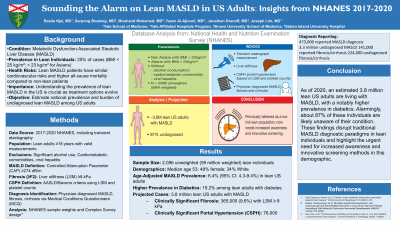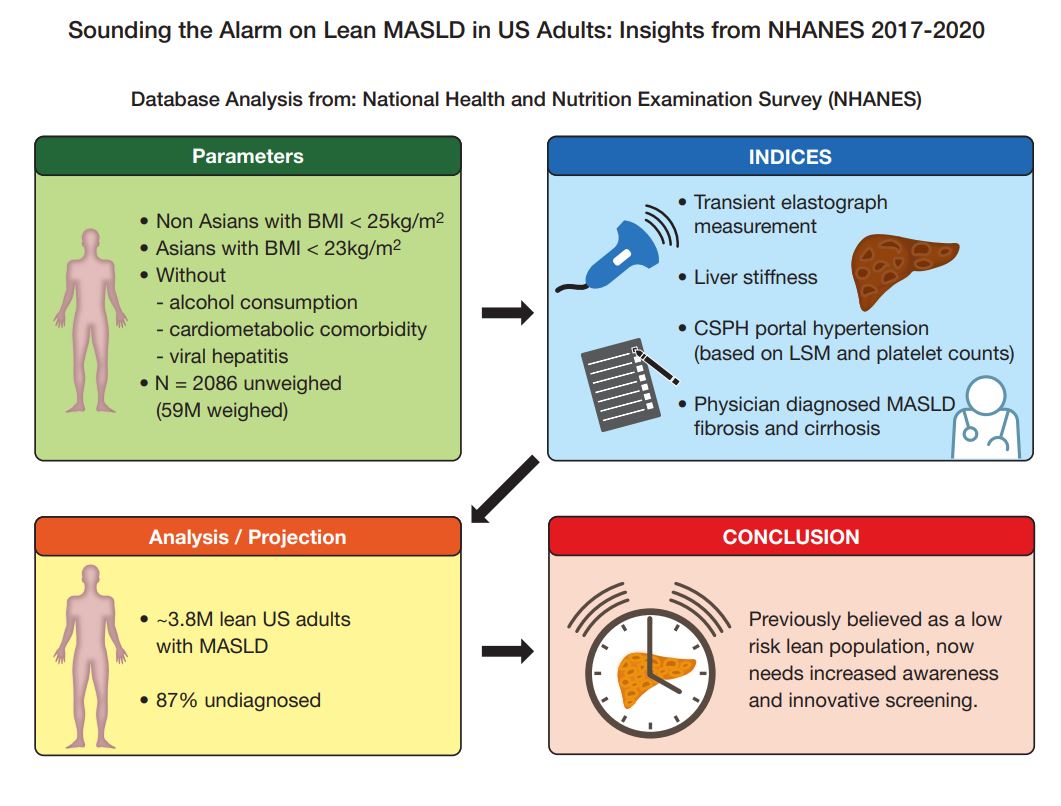Monday Poster Session
Category: Liver
P2977 - Sounding the Alarm on Lean MASLD in US Adults: Insights From NHANES 2017-2020
Monday, October 28, 2024
10:30 AM - 4:00 PM ET
Location: Exhibit Hall E

Has Audio

Basile Njei, MD
Yale University School of Medicine
New Haven, CT
Presenting Author(s)
Basile Njei, MD1, Sarpong Boateng, MD2, Mouhand Mohamed, MD3, Yazan Al-Ajlouni, MD4, Jonathan Dranoff, MD5, Joseph Lim, MD1
1Yale University School of Medicine, New Haven, CT; 2Yale University School of Medicine, Bridgeport, CT; 3Brown University, Providence, RI; 4Staten Island University Hospital, Northwell Health, New York, NY; 5Yale University Medical Center, New Haven, CT
Introduction: Metabolic dysfunction-associated steatotic liver disease (MASLD) is prevalent among overweight/obese (non-lean) individuals. However, around 25% of MASLD patients are lean (BMI < 25 kg/m2, or < 23 kg/m2 for Asians). Despite a generally healthier baseline cardiometabolic profile, lean individuals with MASLD face a similar risk of cardiovascular events and a heightened risk of all-cause mortality as their non-lean counterparts. Given the evolving landscape of MASLD treatments, understanding the prevalence of lean MASLD in the US is essential. This study aims to estimate the national prevalence of lean MASLD among US adults. Moreover, it estimates the burden of undiagnosed lean MASLD in US adults.
Methods: We analyzed 2017-2020 National Health and Nutrition Examination Survey (NHANES) data, including transient elastography. Lean adults ≥18 years with valid measurements were included, excluding those with significant alcohol consumption, cardiometabolic comorbidities, or viral hepatitis. MASLD was defined as a Controlled Attenuation Parameter (CAP) ≥274 dB/m. Liver stiffness (LSM) ≥8 kPa indicated clinically significant fibrosis (≥F2), and clinically significant portal hypertension (CSPH) was defined using AASLD/Baveno criteria based on LSM and platelet counts. Physician-diagnosed MASLD, fibrosis, and cirrhosis were identified using the Medical Conditions Questionnaire (MCQ). Analyses accounted for NHANES sample weights and complex survey design.
Results: Our sample included 2,086 unweighted (59 million weighted) lean individuals (median age 53; 48% female; 34% White). The age-adjusted MASLD prevalence in lean US adults was 6.4% (95% CI: 4.3-9.4%). Among lean adults with diabetes, this prevalence was higher, 19.2%. NHANES data projected 3.8 million (M) lean US adults with MASLD, of whom 365 thousand (9.6%) had LSM ≥ 8 kPa and 76 thousand had CSPH. In our weighted analysis of the NHANES MCQ, only 473 thousand lean US civilian adults reported a diagnosis of MASLD (3.3 M undiagnosed), and 141 thousand reported fibrosis/cirrhosis (224 thousand undiagnosed).
Discussion: As of 2020, an estimated 3.8 million lean US adults are living with MASLD, with a notably higher prevalence in diabetics. Alarmingly, about 87% of these individuals are likely unaware of their condition. These findings disrupt traditional MASLD diagnostic paradigms in lean individuals and highlight the urgent need for increased awareness and innovative screening methods in this demographic.

Disclosures:
Basile Njei, MD1, Sarpong Boateng, MD2, Mouhand Mohamed, MD3, Yazan Al-Ajlouni, MD4, Jonathan Dranoff, MD5, Joseph Lim, MD1. P2977 - Sounding the Alarm on Lean MASLD in US Adults: Insights From NHANES 2017-2020, ACG 2024 Annual Scientific Meeting Abstracts. Philadelphia, PA: American College of Gastroenterology.
1Yale University School of Medicine, New Haven, CT; 2Yale University School of Medicine, Bridgeport, CT; 3Brown University, Providence, RI; 4Staten Island University Hospital, Northwell Health, New York, NY; 5Yale University Medical Center, New Haven, CT
Introduction: Metabolic dysfunction-associated steatotic liver disease (MASLD) is prevalent among overweight/obese (non-lean) individuals. However, around 25% of MASLD patients are lean (BMI < 25 kg/m2, or < 23 kg/m2 for Asians). Despite a generally healthier baseline cardiometabolic profile, lean individuals with MASLD face a similar risk of cardiovascular events and a heightened risk of all-cause mortality as their non-lean counterparts. Given the evolving landscape of MASLD treatments, understanding the prevalence of lean MASLD in the US is essential. This study aims to estimate the national prevalence of lean MASLD among US adults. Moreover, it estimates the burden of undiagnosed lean MASLD in US adults.
Methods: We analyzed 2017-2020 National Health and Nutrition Examination Survey (NHANES) data, including transient elastography. Lean adults ≥18 years with valid measurements were included, excluding those with significant alcohol consumption, cardiometabolic comorbidities, or viral hepatitis. MASLD was defined as a Controlled Attenuation Parameter (CAP) ≥274 dB/m. Liver stiffness (LSM) ≥8 kPa indicated clinically significant fibrosis (≥F2), and clinically significant portal hypertension (CSPH) was defined using AASLD/Baveno criteria based on LSM and platelet counts. Physician-diagnosed MASLD, fibrosis, and cirrhosis were identified using the Medical Conditions Questionnaire (MCQ). Analyses accounted for NHANES sample weights and complex survey design.
Results: Our sample included 2,086 unweighted (59 million weighted) lean individuals (median age 53; 48% female; 34% White). The age-adjusted MASLD prevalence in lean US adults was 6.4% (95% CI: 4.3-9.4%). Among lean adults with diabetes, this prevalence was higher, 19.2%. NHANES data projected 3.8 million (M) lean US adults with MASLD, of whom 365 thousand (9.6%) had LSM ≥ 8 kPa and 76 thousand had CSPH. In our weighted analysis of the NHANES MCQ, only 473 thousand lean US civilian adults reported a diagnosis of MASLD (3.3 M undiagnosed), and 141 thousand reported fibrosis/cirrhosis (224 thousand undiagnosed).
Discussion: As of 2020, an estimated 3.8 million lean US adults are living with MASLD, with a notably higher prevalence in diabetics. Alarmingly, about 87% of these individuals are likely unaware of their condition. These findings disrupt traditional MASLD diagnostic paradigms in lean individuals and highlight the urgent need for increased awareness and innovative screening methods in this demographic.

Figure: Analysis of NHANES data from 2,086 lean adults reveals that approximately 3.8 million lean US adults have MASLD, with 87% undiagnosed. The study emphasizes that lean individuals are at risk and need increased awareness and innovative screening for MASLD.
Disclosures:
Basile Njei indicated no relevant financial relationships.
Sarpong Boateng indicated no relevant financial relationships.
Mouhand Mohamed indicated no relevant financial relationships.
Yazan Al-Ajlouni indicated no relevant financial relationships.
Jonathan Dranoff indicated no relevant financial relationships.
Joseph Lim: Gilead Sciences – Grant/Research Support. Intercept – Grant/Research Support. Inventiva – Grant/Research Support. Novo Nordisk – Grant/Research Support. Pfizer – Grant/Research Support. Viking Therapeutics – Grant/Research Support.
Basile Njei, MD1, Sarpong Boateng, MD2, Mouhand Mohamed, MD3, Yazan Al-Ajlouni, MD4, Jonathan Dranoff, MD5, Joseph Lim, MD1. P2977 - Sounding the Alarm on Lean MASLD in US Adults: Insights From NHANES 2017-2020, ACG 2024 Annual Scientific Meeting Abstracts. Philadelphia, PA: American College of Gastroenterology.
